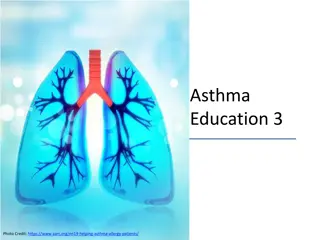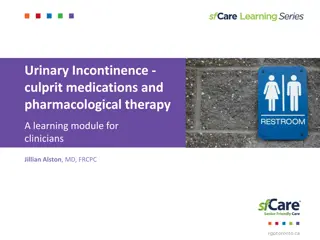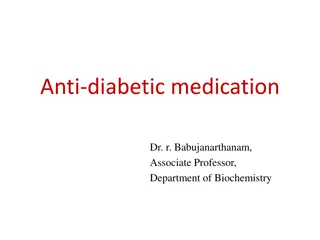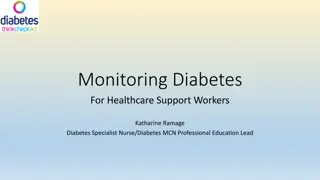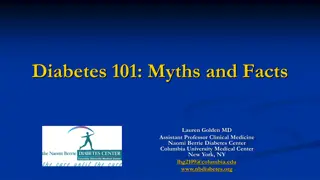Common Side Effects of Diabetes Medications
Common side effects of diabetes medications include skin reactions, stomach issues, headaches, and more. Insulin injections may lead to localized or generalized reactions, while oral hypoglycemic drugs can cause gastrointestinal disturbances. Understanding these side effects is crucial for managing diabetes effectively.
Download Presentation

Please find below an Image/Link to download the presentation.
The content on the website is provided AS IS for your information and personal use only. It may not be sold, licensed, or shared on other websites without obtaining consent from the author.If you encounter any issues during the download, it is possible that the publisher has removed the file from their server.
You are allowed to download the files provided on this website for personal or commercial use, subject to the condition that they are used lawfully. All files are the property of their respective owners.
The content on the website is provided AS IS for your information and personal use only. It may not be sold, licensed, or shared on other websites without obtaining consent from the author.
E N D
Presentation Transcript
Insulin A/ Insulin A/E E Immediate Localized/ Generalised erythema, urticaria. Delayed Itchy nodule 4-24 h after injection Lipoatrophy Circumscribed depressed areas 6-24/12 after starting Rx lypolytic component of insulin preparation, immune complex mediated inflammation Less common with purified recombinant human insulins Lipohypertrophy Soft nodules resembling lipoma Local response to lipogenic action of insulin Preventable by rotating injection sites
Oral hypoglycemic drugs Oral hypoglycemic drugs A/ A/E E metformin: Acute Infection of the Nose, Throat or Sinus Diarrhea Vomiting Headache Inadequate Vitamin B12 Stomach Cramps Swelling of the Abdomen Taste Problems(MetalicTaste)
Trouble Breathing (DOB) Chills Dizzyness Excessive Sweating Fingernail and/or Toenail Disease Flu-Like Symptoms Heart Throbbing or Pounding Incomplete or Infrequent Bowel Indigestion Muscle Pain Skin rashes .. Temporary Redness of Face and Neck
Sulfonylureas Glimepiride (Amaryl) Glyburide (Diabeta, Micronase) Glipizide (Glucotrol, Glucotrol XL) Micronized glyburide (Glynase) occasional skin rash, irritability upset stomach Low blood glucose
Thiazolidinediones Pioglitazone (TZDs) Pioglitazone (Actos) May cause side effects such as swelling (edema) or fluid retention.
Drug Drug- -Induced Generalized Skin Induced Generalized Skin Eruption in a Diabetes Mellitus Eruption in a Diabetes Mellitus Patient Receiving a Patient Receiving a Dipeptidyl Peptidase Peptidase- -4 4 Inhibitor Plus Inhibitor Plus Metformin Dipeptidyl Metformin
Case Report Case Report 66-year-old male with untreated type 2 DM was admitted to the hospital following the advice of the. The patient s hemoglobin A1c (HbA1c) level had been 7.4% in a general health check-up 3 years before. One year prior to admission, the patient s fasting glucose had risen to 126 mg/dL and his HbA1clevel rose up to 8.6%. The patient had a history of urticaria several years earlier. A diet and exercise regimen was introduced, and sitagliptin phosphate 50 mg and metformin 500 mg were started. Two months later, the patient s HbA1clevel had improved to 7.0% and the patient continued on the medication, and diet and exercise therapy. Six months later, a rash with a locus on the upper limb began to appear. The patient applied antihistamine ointment on the skin rash, which continued to spread gradually from chest to back, and abdomen to thigh (Figs.1a, a,2a,2a, ,3a,3a, b).
In some areas of the back and chest, lichenification also appeared. The itching associated with the rash also worsened, interfering with sleep during the night. The patient consulted a dermatologist, and oral and ointment steroids were started. However, the rash was unchanged and pruritus gradually increased
Since there is a possibility of skin malignancy in eczematous skin rashes lasting for a long period of time, a skin biopsy was scheduled. Four months after the eruption first appeared, and just before the skin biopsy, the authors stopped the dipeptidyl peptidase-4 (DPP-4), sitagliptin, to rule out the possibility of a drug reaction, although metformin was continued. Itching caused by the rash was significantly relieved immediately after discontinuation of the drug.
emergence of new rash ended, and the rash itself withered after 1 week. The spread of the rash gradually shrank and the skin lesions subsided, leaving pigmentation 1 month later (Figs.1b, b,2b).2b). Although discontinuation of sitagliptin was significantly effective for the skin rash, a drug-induced lymphocyte stimulation test was negative for sitagliptin. Nonspecific radioimmunosorbent test for immunoglobulin E was increased to 532 IU/mL, and the percentage of eosinophil was 7.4%. Two months after cessation of sitagliptin, the skin eruption had subsided (Figs.1c, c,2c)2c) and oral steroid medication was stopped, but some small eczematous eruptions continued to appear intermittently.
Chest just before discontinuation of sitagliptin (a a), after 1 month (b b), after 2 months (c c
Discussion Discussion Sitagliptin was the first DPP-4 inhibitor approved by the US Food and Drug Administration (FDA) in October 2006, for the treatment of type 2 diabetes mellitus. Of the spontaneous adverse event reports of hypersensitivity reactions (such as anaphylaxis, angioedema, and serious skin reactions), most have occurred within the first 3 months after initiation of the treatment, with many following the first dose.
According to the Uppsala Monitoring Centre (a World Health Organization collaborating center) causality assessment system the category for the present case is certain, although the appearance of the adverse event occurred about 6 months after sitagliptin initiation In the literature, skin rash induced by sitagliptin has so far been reported in only two cases, one of persistent edematous- plaque photosensitivity [6] and another of bullous pemphigoid [7];the former a cutaneous eruption induced by a photosensitive reaction to sitagliptin that appeared about 2 weeks after starting sitagliptin but continued for almost 2 years after cessation. In the present case, the eruption appeared almost 6 months after initiation of the drug and gradually subsided after the cessation, except for small itchy erythematous eruptions that continue to.
Because sitagliptin, like all known photosensitizers, has a phenyl ring, carbonyl group, and an absorption spectrum showing three absorption peaks (199.9, 265.0, and 400.1 nm),
both the 199.0 and 265.0 nm wavelengths are within the UV-C spectrum, the 400.1 nm absorbance peak indicates that sitagliptin also absorbs UV-A-visible light. Thus, sitagliptin could cause persistent photosensitive eruption after cessation of the drug even with protection from UV light by hapten formation with subcutaneous protein. UV protection Avoid sun
Conclusion Conclusion In the present case, the initial generalized skin eruption may have been induced by an allergic reaction to sitagliptin. Close attention should be paid to patients receiving this drug with a history of urticaria, and to the development of photosensitivity.
sitagliptin+ sitagliptin+metformin Fixed Fixed- -Drug Eruption Confirmed Drug Eruption Confirmed by Multiple Exposures by Multiple Exposures metformin- -Induced Induced
Case Report Case Report A 46 year-old woman presented in our centre . suffering from type II DM for the past three years and was being managed with tablet metformin 500 mg twice daily, but one week prior to the onset of skin lesions the patient was also started on tablet Sitagliptin 50 mg/day by her physician in view of the poor glycemic control. After the sixth dose of Sitagliptin, patient noticed multiple circumscribed, reddish lesions over the lips and hands which were associated with burning sensation, which over the next two days progressed to involve the trunk and lower extremities. There was no history of any other drug intake prior to the eruption or any similar lesions in the past
On muco-cutaneous examination, multiple circumscribed erythematous and hyperpigmented round macules were present over the lips, trunk and the extremities whereas the oral and genital mucosae showed the presence of well defined erosions (Figure 1). Nails and hair examination revealed no abnormality. Laboratory tests, including full blood count and biochemistry profile including liver and renal functions, were within normal limits, except for blood glucose, with a value of 167 mg/dl
A skin biopsy was performed and the histopathological examination revealed a dense band like lymphocytic infiltrate, perivascular inflammatory infiltrate, eosinophils and increased pigment incontinence suggestive of fixed drug eruption (Figure 2).
At this junction, a diagnosis of FDE was made and all the drugs were discontinued and the patient was started on Prednisolone 40 mg/day and Glimepride. Five days after initiation of oral corticosteroids, the lesions subsided with residual hyperpigmentation. Two weeks later, oral provocation was done, after taking informed consent, and initially metformin was given in full therapeutic dose but no recurrence was observed.
After another two weeks, patient was administered Sitagliptin 50 mg and within six hours of administration, there was recurrence of lesions in the form of itching and erythema over the residual pigmented lesions . The patient was again started on a short course of oral corticosteroids and antihistamines which led to clearance of lesions.
Discussion Discussion Sitagliptin has been reported to induce a wide array of cutaneousA/E including psoriasiform eruption maculopapular rash Stevens Johnson syndrome toxic epidermal necrolysis anaphylaxis cutaneous vasculitis bullous pemphigoid photosensitivity Angioedema with ACEI[1,4-7]..
Conclusion Conclusion Cutaneous adverse effects have been reported with Sitagliptin but this is the first case of FDE reported with it. The healthcare providers should be fully aware of the various adverse effects of the drug in order to prevent recurrences and for rapid diagnosis and proper management of the same.
Psoriasiform Psoriasiform drug eruption drug eruption associated with associated with metformin hydrochloride: hydrochloride: metformin
Case report. Case report. An 18 year-old-woman presented with a 1-week history of a psoriasiform eruption on her limbs and trunk that began 1 week after starting metformin hydrochloride. She had taken no other medications. She had no personal or family history of psoriasis. The lesions disappeared within 5 weeks after discontinuation of the drug. In the 4 months following the cessation of metformin hydrochloride, no relapse was observed, but rechallenge with oral metformin again produced the eruption.
Conclusion Conclusion Metformin hydrochloride should be added to the list of drugs that can cause a psoriasiform eruption
Metformin Metformin- -Induced Fixed Induced Fixed- -Drug Eruption Confirmed by Multiple Eruption Confirmed by Multiple Exposures Exposures Drug
Patient: Female, 56 Final Diagnosis: Fixed-drug eruption Symptoms: Medication: Metformin Clinical Procedure: Discontinued metformin Specialty: Family Medicine
Case Report Case Report We describe a 56-year-old woman who developed a FDE with multiple exposures to metformin. Upon each exposure, small, round, erythematic lesions developed on the palms of the hands and soles of the feet; these lesions resolved each time after discontinuation of metformin.
Conclusions Conclusions This report contributes to the limited documented literature on metformin-induced FDE. Clinicians should be made aware of possible FDEs associated with this commonly used medication.
Case reports of possible reactions to metformin include erythema multiforme lichen planus rosacea and pseudoporphyria [3 6] The 2nd most common drug- induced cutaneous reactions are fixed- drug eruptions (FDEs)
Any skin rash Any skin rash -------- -------- with Any DM medication with Any DM medication

 undefined
undefined








